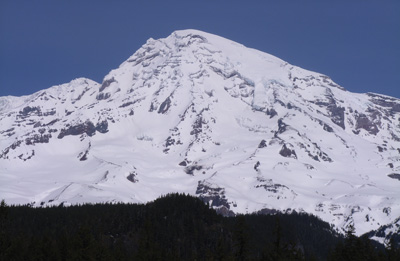Adventure Journey Magazine has a well written article on their website about climbing Mt. Rainier, in which the author, Roland Redcane, reveals his personal motivations and experiences climbing the 14,410 foot mountain.
Roland first became interested in climbing when he was shown a photo of Everest taken from an airplane. Reading Into Thin Air only encouraged his adventurous spirit. Later, he had the chance to travel to Nepal, and hoped to see the mountain first hand, but bad weather conditions prevented that from happening. Still the mountains called to him and he had a desire to begin climbing.
After giving ice climbing a brief go, he later decided that he wanted to take a shot at climbing Rainier. The article recounts that climb, and gives insight to what it was like for Roland, a non-climber, to go up that mountain. One of the most well known and compelling in North America. With a day by day description of his climb, Roland offers up very good insights into what a beginning mountaineer should expect when setting out on such a trek. Namely, be prepared to suffer along the way.
An excellent read and definitely recommended for someone thinking of doing a Rainier climb or something similar.
- Gear Review: The Xero Scrambler Mid is an Ultralight Hiking Shoe for Spring - March 1, 2023
- Gear Review: Yeti Roadie 48 Wheeled Cooler - August 18, 2022
- Kristin Harila Continues Pursuit of 8000-Meter Speed Record - August 16, 2022

A couple of thoughts for anyone considering doing this:
1) You should do it.
2) There are three guide services on Rainier — Rainier Mountaineering had the exclusive contract for a number of years, but the Parks Service opened up the contract and International Mountain Guides and Alpine Ascents also lead trips now. I went up with RMI two years ago and IMG a few weeks ago, and I’d definitely recommend IMG. No complaints about RMI, they were great, highly qualified of course, but the trips are different.
Because of the wording of RMI’s contract, they can only camp at Camp Muir at 10,000′, so you’re limited to climbing to Camp Muir on day one, getting up at midnight, climbing all the way to 14,411′, then all the way back down to 5,400′ on day two. It’s really brutal.
IMG does a three day climb. Day one, you still hike up to Camp Muir. Day two, you still need to do climb school anyway, so they just do it right there on the mountain. So after getting to sleep in until a luxurious 7AM or so, you spend the morning learning how to deal with the ropes, ice axe, crampons, etc. Then you hike for about an hour and a half and 1100′ vertical up to the Ingraham Flats, and camp there in tents that are already set up. So on summit day, day three, when you’re about to head up the Disappointment Cleaver, you had a relatively easy day on day two so you’re more rested, and you’ve had an extra day to acclimatize to the altitude. And you just woke up, as opposed to having already climbed 1100′. It makes a huge difference. They even occasionally do a four-day where you spend one extra full day at Camp Muir, for people who really think they need extra time to acclimatize.
Also, IMG cooks breakfast and dinner for you. Good food, too. Chicken pesto pasta, chicken yakisoba, potato soup… breakfast at Camp Muir was freshly cooked blueberry pancakes and bacon, hot water for coffee, hot chocoate, or apple cider, and on our trip, one of the guides had actually hiked up with a bowling ball-sized whole watermelon. Not having to make your own meals is one less thing to deal with, and if you’re cold and tired, a good hot meal really gives you a boost.
3) You learn so much by watching the guides, seeing what they wear, but in particular, seeing what they eat. Everybody had trail mix and various bars and stuff. The guides had real food. Huge bagel and meat loaf sandwiches, foil pouches of tuna, that kind of stuff. If I ever did this again, other than a few pouches of Gu, I’ll do my food shopping at the grocery store, not at REI. The IMG guides did say that they would be putting a section on their web site soon where the guides listed their favorite foods to bring.
Awesome! Thanks for the advice and tips Greg. Very much appreciated.
Into thin air seems to be the leaping off point for a lot of people, including me.
Yep! It’s easily the most influential book on high altitude mountaineering of the past 50 years or so. The events of 1996, and the book that followed, really gripped the imagination of the general public for sure.
No spam please!